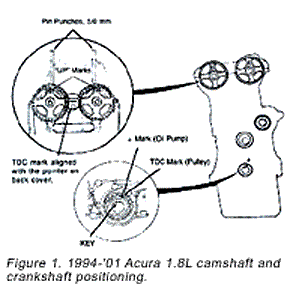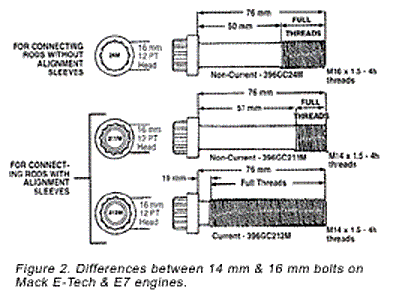Engine Builders: The following information is for installers regarding timing belt installation procedures on 1994-2001 Acura B18 Series engines. Failure to follow these procedures could result in engine damage.

Position the crankshaft and the camshaft pulleys as shown in Figure 1 before installing the timing belt.
Set the crankshaft so that the No. 1 piston is at top dead center (TDC). Align the groove on the teeth side of the timing belt drive pulley to the (arrow mark) pointer on the oil pump.
Align the TDC marks on intake and exhaust pulleys.
NOTE: To set the camshafts at TDC position for No. 1 piston, align the holes in the camshafts with the holes in No. 1 camshaft holders and insert 5.0 mm pin punches in the holes.
Install the timing belt tightly. Loosen and retighten the adjusting bolt to tension the belt. Remove the pin punches. Rotate the crankshaft about 4 or 6 turns counterclockwise so that the belt positions on the pulleys. Adjust the timing belt tension. Check the crankshaft pulley and the camshaft pulleys at TDC. They should line up.
If a camshaft pulley is not positioned at TDC, remove the timing belt and adjust the positioning, then reinstall the timing belt.
Engine Builders: There is a revised connecting rod cap screw on Mack E-Tech & E7 PLN engines. This change occurred during production of these engines beginning September 14, 1999.

The fully threaded shank identifies this new cap screw. Previous connecting rod cap screws had a long neck down shank as shown at the top in Figure 2. As a positive means of identification, the part number suffix can be found on the head of each cap screw as well.
The two 14 mm connecting rod cap screws shown in the lower portion of Figure 2 are to be used with connecting rods that have alignment sleeves in the rods. The 211M & 212M on the head of the bolts identifies them. The 16 mm cap screw is used on early E7 PLN engines having connecting rods without alignment sleeves and are identified by the 24M on the head of the bolt.
To provide strict control of torque on these rods, an angle torque method has been added to the two 14 mm cap screws. Torque values for the three connecting rod cap screws are as follows:
396GC24M













